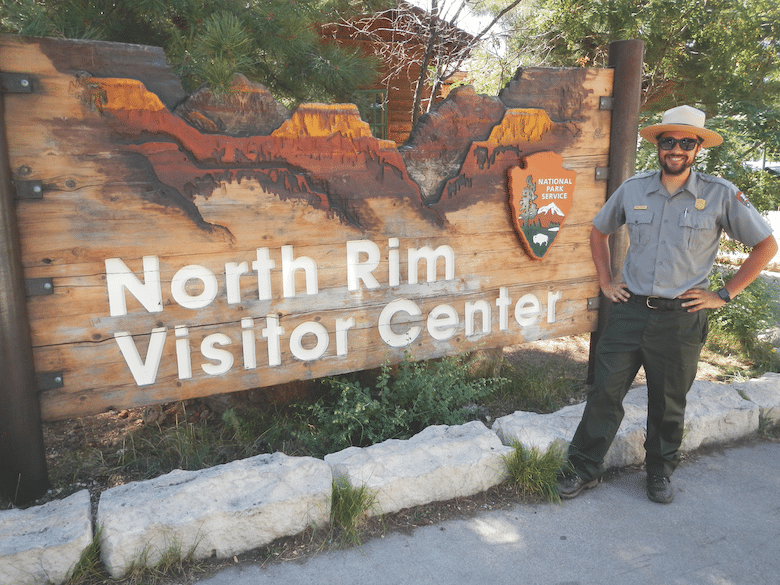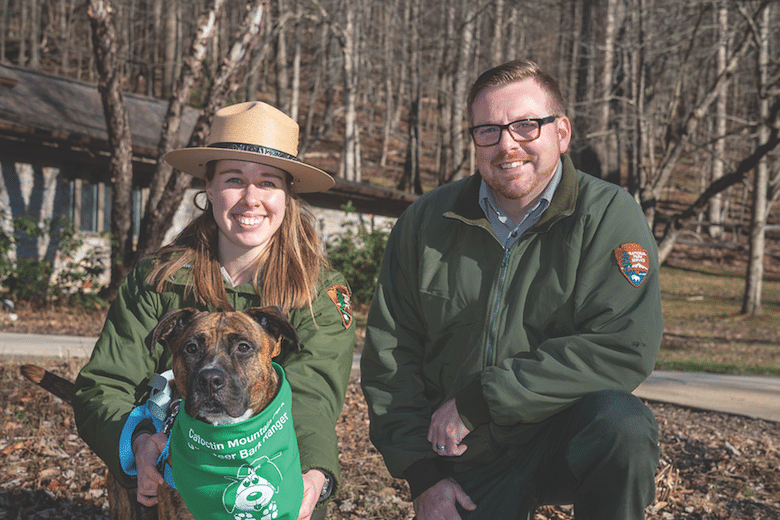Join the National Park Service’s Park — or Rather — B.A.R.K. Rangers
Chances are, as a child, teen or adult, you wondered what it would be like to be a Park Ranger at one of America’s National Parks: enjoying the great outdoors, preserving history and sharing your knowledge with visitors. But it just may be that your dog has been daydreaming of being a “bark ranger.”
Well, that canine dream might come true the next time you visit a National Park. The National Park Service (NPS) offers many opportunities for pets and their human companions to enjoy the scenery, trails and environments of our nation’s most beautiful and historic places with its more than 420 national parks. The “B.A.R.K. Ranger” program offered at many of the parks enables dogs to have some family fun without being overstimulated or unsafe.

National Park Service Ranger Daniel Willner hosts a Grand Canyon National Park B.A.R.K. Ranger hike. Photo: Dr. Stephenie Slahor
What is the B.A.R.K. Ranger program
“B.A.R.K.” is actually an acronym for the four principles involved in the NPS’s Healthy People, Healthy Parks initiative:
- B is for bagging your pet’s waste and disposing of it in a public garbage receptacle, never leaving it on a trail, pathway or in the woods or wild lands.
- A is for always keeping your pet on a leash no longer than 6 feet so that you have control of your pet.
- R stands for respecting the park’s wildlife.
- K is for knowing which areas of the park are dog-friendly sites where your pet is welcome or where your pet can hike with you.
How does the B.A.R.K. Ranger program works?
Grand Canyon National Park is just one National Park where the free B.A.R.K. Ranger program is offered. Park Ranger Daniel Willner organizes a pets-and-humans walk along one of the canyon’s rim trails that is open to pets.
Not all of the parks have a B.A.R.K. Ranger program. “When creating a B.A.R.K. Ranger program, some considerations, among others, include the location, safety, logistics, permits (if necessary), the purpose of the program and the takeaways you would like the participant to experience,” he says.
Once a park sets up the program, it is time to get the word out to the guests at the lodges, the campers and the day-use visitors.
Ranger Willner explains, “There are many different ways to advertise a B.A.R.K. Ranger program; however, the platforms that I have found to be most successful have been posting fliers in the various contact stations and campgrounds, including the program in the Ranger Talks schedule (of lectures and presentations), as well as the park website.”
Check all of these platforms to see if the park you are visiting currently has the program.

Rangers pose with a Catoctin Mountain Park B.A.R.K. Ranger. This Western Maryland national park has 25 miles of hiking trails. Photo: NPS.gov
Join in the fun
To participate, all candidates for the honor of being a B.A.R.K. Ranger need to have two of the important characteristics of the human park rangers: being friendly and being sociable. The pet parents who would accompany the pets on the two-hour interpretive walk are asked to bring along water and snacks for themselves and their dog, waste bags, sunscreen and the B.A.R.K. Ranger booklet given to participants.
Once the pet parents and dog complete a B.A.R.K. Ranger program, the activity card or booklet can be taken to a park ranger to validate. The dog then earns the right to wear the coveted B.A.R.K. Ranger dog tag, bandana or both. Some National Parks provide them free of charge and others have a minimal cost.
Find a B.A.R.K. Ranger Program
Here’s a list of some of the current sites but, as in many things, it is subject to change depending on having staff to conduct the program, budget, time and other factors. Check with that park near your home or at your vacation destination to get the latest information about bringing your pet.
Start with nps.gov/subjects/pets/visit.html to see a map of parks. The ones marked in red prohibit pets, but the ones in green will have the “welcome” mat out. Just be sure your pet is on a leash and that the mat has no “deposits!” By the way, cats are also included as pets for the purposes of the map. B.A.R.K. Ranger programs:
- Yosemite National Park, California
- Shenandoah National Park, Virginia
- North Cascades National Park, Washington
- Cuyahoga Valley National Park, Ohio
- Mammoth Cave National Park, Kentucky
- Grand Canyon National Park, Arizona
- Acadia National Park, Maine (considered one of
the most dog-friendly)
Remember, too, that the National Park system has many other sites for history, culture, lakes, canals, islands, terrain, etc.
Here are some that offer special considerations for pets:
- The Carl Sandburg Home National Historic Site, North Carolina
- Castillo de San Marcos National Monument, Florida Fort Matanzas, Florida
- Friendship Hill National Historic Site, Pennsylvania
- Herbert Hoover National Historic Site, Iowa
- Pictured Rocks National Lakeshore, Michigan
- Montezuma Castle National Monument, Arizona
And, related to the love of canines is Denali National Park, Alaska, the only National Park with working sled dogs. The kennels are open to park visitors. Demonstrations and tours are more frequent in summer, but the kennels are open all year
Fur family fun
Says Ranger Willner, “I find that the most rewarding aspect of creating and delivering B.A.R.K. Ranger programs is seeing the visitors and their our-legged family members be able to respectfully enjoy the resource together. Pets have a significant effect on our natural spaces, as they are ‘visitors’ to these wild lands and, as visitors, there are house rules that they need to follow that, in the grand scheme, will benefit them as well as the park.”
With pets an important part of family activities, always review the safest ways to enjoy our National Parks when our canines are along for the fun. The B.A.R.K. Ranger program gives dogs and their humans a renewed knowledge of how to be good role models for responsible and safe visits at our National Parks. And, besides, it’s a fun activity!
Read Next: Hiking With Dogs: A Guide to Safely Taking a Hike With Your Dog
